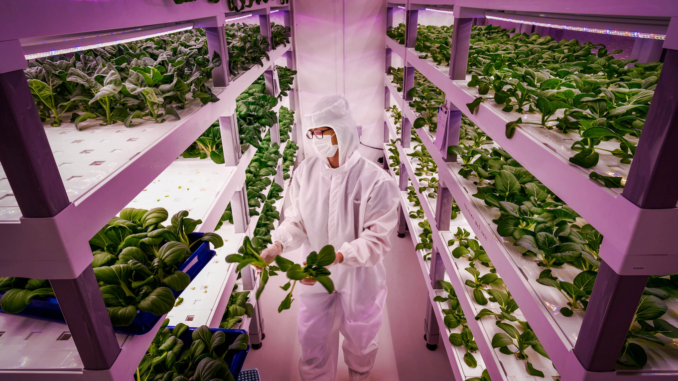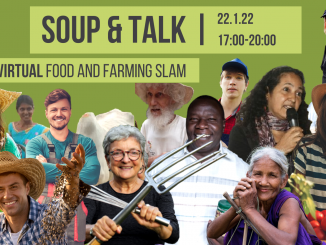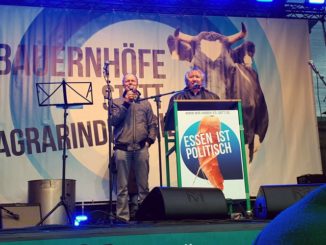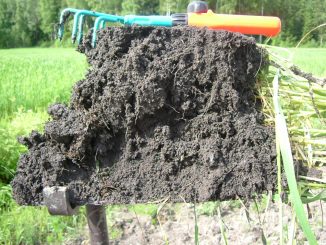
Indoor farming is a growth area, proposed as a solution for a number of problems in the agri-food system. So what is it, and how do we separate the spin from the substance? Andrea Beste with more.
Introduction
Current agricultural practices are under criticism for their impact on ecosystems. Urbanisation progresses and land sealing shrinks the available land for agriculture. As a result, the technique of “indoor farming” is increasingly being discussed, promoted and funded as a solution to multiple problems. With the help of LED lighting plants are grown in indoor spaces, using closed nutrient and water cycles. As of now, the same method features under a number of different labels: indoor farming, vertical farming, hydroponics, aquaponics, Aquaponic Controlled Environment Agriculture (CEA), and even, sometimes, urban farming.
Many reports and promotional texts list as advantages to indoor farming such lower fossil fuel use due to proximity to markets, lower water requirements and fewer pesticides. The “controlled environment” in which the plants grow is described as beneficial to their quality, too. But even protagonists are critical of the high energy needs. A closer look shows that in comparison with produce grown naturally, in a field outside of the city, only one of the advantages holds up to scrutiny: the short transport distance to consumers. And even this benefit does not really hinge on the existence of an artificial system – “urban farming” is also possible in a city, in open air, in good soil (in raised beds) and with natural sunlight.
Let’s take a closer, critical look at these supposed advantages and compare them with so-called “nature-based solutions” for a modern agricultural system as promoted by the FAO. (This article is drawn from the “Greenwashing and high tech” report by Andre Beste, available in full at the link below.
“Over the last three years, indoor farming increasingly has been hailed as the solution.”
Fewer pesticides
True, in such a sealed techno-sphere, certain harmful organisms can be kept at bay and therefore fewer “classic” pesticides are needed to regulate them. But in regard to energy use and plant health the price is high (see below). By comparison, organic agriculture too reduces synthetic chemical pesticide amounts, it uses solar energy directly and delivers a whole host of benefits for soil health, water filtration and biodiversity.
Controlled environment
It is claimed that a controlled quasi-sterile environment has advantages over natural growth. But, even a hospital is not completely sterile and particularly in clinical facilities resistant bacteria become a problem fast. With indoor farming too, there is a risk that humans cannot fully control such germs. No artificial techno-sphere will ever compare to the equilibrium microorganisms achieve naturally. No living being survives for long in a completely sterile environment. The more disinfectants are used to keep the tech-farms clean, the higher the risk that individual bacterial strains develop resistance and are able to multiply because there are no antagonists that could keep them in check.
Today we know that the guiding principle for the balance of ecosystems also applies to an environment (such as our gut) that is inhabited by different strains of bacteria (microbiomes): the higher the diversity the healthier. A “germ free” environment is therefore highly vulnerable to the infestation with single strands of bacteria. Moreover: a food production system that is completely dependent on functioning power circuits is very vulnerable to power cuts and sabotage.
“Artificial nutrient solution cannot replace a natural biosphere.”
Quality of plants
Plants react to stress by producing secondary plant compounds which are particularly valuable to human health. It is difficult to produce high quality food without stimulants in the natural biosphere and the interaction with soil organisms which have a considerable influence on the resilience and health of plants. In the wild, plants mainly live in symbiosis. They have access to a microbiome that takes care of a variety of processes within the plant – one of these is the defense against pests. A completely artificial nutrient solution can hardly replace the quality of the nutrition naturally provided by the soil. In a 2003 article in the Journal of Agricultural and Food Chemistry, it was found that the carotenoid content of hydroponically grown vegetables is lower than that of conventionally grown vegetables.
Foods grown in healthy soil have always been an important part of the human diet, providing vital microbes that play an important role in gut health and our immune system. For that reason, a hundred years ago, organic agriculture decided against the use of artificial, synthetic fertilisers (which destroy the finely tuned interplay between plant and soil). For that reason, the EU regulation on organic farming does not allow for plants to be grown in nutrient solutions. In Europe, plants from indoor farms therefore cannot get organic certification. Whether through cleanliness – and thus the missing biome – the resulting weak immune system of plants could endanger the human immune system and possibly carry a higher risk of autoimmune diseases and allergies, up to now remains an unanswered question. More research is needed.
“A plant lab on sealed ground impedes the formation of drinking water instead of preserving it.”
Low water consumption
The arguments the proponents of indoor farming make regarding water consumption can only be called frivolous. Statements about low water consumption may be appropriate in comparison to highly industrialised irrigated monocultures in a desert. Compared with sustainable agroecological field systems however, the argument is utterly lopsided. Agroecological systems not only absorb, retain and filter rainwater which then goes towards groundwater recharge, such systems also protect from erosion and flooding, and they have a positive influence on microclimates and thereby help balance local temperatures and precipitation. Indoor farming can do none of the above, on the contrary, through its existence it prevents water and substance exchange between soil and atmosphere.
If soil is under good management, most of the rain that falls on it seeps in. Some of the water is stored for a longer period of time and is available to plants and soil animals, while the rest percolates away in a purified form and contributes to groundwater formation. Organic farming supports a good soil structure that is less susceptible to erosion and can store significantly more water than conventional managed soil. This is largely due to the much better soil structure, which has a much higher aggregate stability. In contrast a plant lab on sealed ground impedes the groundwater formation instead of preserving it.
On a superficial level, indoor farming seems to compare rather well with the industrial agriculture as it is currently practiced. But, as the above mentioned points show, it is frivolous to present the concept of indoor farming as a solution to the problems inherent to industrial agriculture. To argue that the current problems of soil-based management systems – the stress of industrialisation and urbanisation as well as the intensive use of fertilisers and pesticides in agriculture which lead to a loss of soil fertility – can be solved by shifting plant production into automatically controlled artificial techno-spheres looks, seems naïve, if not presumptuous.
Weighted interests – Scientific Endeavour or Product Development?
For years, public funding for science in Europe has decreased. From 2000 to 2010 for example, third party funding for German universities has more than doubled, from 2.8 billion Euro to roughly 5.9 billion Euro. By now, in Germany, every second Euro in science funding comes from the private sector. The EU research programme “Horizon Europe“ heavily relies on private-public funding, too. However: no large company is interested in giving away money. There is usually a purpose for donating money, for example towards endowed chairs: the purpose is to increase profits. Corporations aren’t charities.
More and more research is geared towards a product or a technology that is ready to sell – that’s particularly true for the environment and sustainability market. Often the market is developing in parallel to the research, as a result there is little interest in “discrediting” the product or the technology through critical research or by coming to the realisation that doing without a harmful technology may be better than switching to a new, superficially beneficial new technology.
At the same time, less and less fundamental research is done – independent research that deals with risks and technology assessments without fixed expectations or simply asks the question whether a newly invented “innovation” actually makes sense. Whether it is gene technology, bioenergy, biochar, or digital technology for agriculture, for years the assessments of such technologies were rarely based on scientific approaches and critical questions.
With increasing frequency, the early evaluation of these one-sided positive reviews of certain techniques and, more often than note, their unmasking, is up to NGOs. Today, NGOs do their work to a much more professional standard and they count many proven experts among their staff and support networks, but it definitely isn’t their job to replace publicly funded risk research. In Europe, much more independent risk and technology assessment is needed so that decisions about technologies which often enough lead to far reaching interventions and have wide social and ecological implications are not only dependent on assessments by “lobby experts”.
“As economic interests gain ever more influence on research, practical application becomes a must and critical questions are not asked.”
Narrowing the view
A one-sided approach to research is not necessarily always connected to third party funding. University education has been split up into ever more specialised disciplines. And within these bubbles of specialisation the quest for solutions is increasingly shaped by a one-problem-one-solution approach. Fitting into complex ecosystems (even if they have not been fully understood) is less and less perceived as innovation. Solutions are mostly considered to be “innovative” if they involve complicated technology that few people understand and they are based on the assumption that all aspects of an ecosystem can be controlled. But what may yield very good results in engineering can be counterproductive, inefficient and sometimes even dangerous when applied within the context of ecology.
Apparently, the dream of the technical controllability of biological systems still is far from over. For years, agriculture’s fascination with the possibilities of interference that technology and chemistry can provide was the result of the (wrong) impression that such fixes are simple, targeted, controllable and without negative side effects.
Today we know that in many instances this was a total misconception. It’s been mentioned already that it is often far more effective to “search” than to “construct”. The technique of searching before starting to construct has a long tradition: in indigenous, highly adapted network systems, in organic agriculture but also in bionics. This approach observes patterns of action in nature which have successfully stood the test of time and evolution and then copies them. In terms of the overall energy investment and the cost-benefit analysis, this is often much more effective. We need to get away from “tech fixes”, instead our use of ecosystems needs to be better adapted to their functionality which has been shaped through evolution. From a geo-ecological time-perspective, we have been on this earth for less than it takes to bat an eyelid. Should that not be a good enough reason to value and use the “experience” that organisms and ecosystems all around us have gathered over millennia?
Changing the systems towards food sovereignty and agroecology brings about invaluable advantages for ecosystems and the livelihoods of billions of people.
A look ahead
In March 2021, the international group of experts for sustainable food systems (IPES Food) reiterated the main conclusions of the 2009 Agriculture at a crossroads – Report: It is clear that, if the future continues to be dominated by industrial agriculture, the planet and our food systems will not reach a state in which their survival seems possible. But techno-fixes will not help us out of that. It’s changing the systems towards food sovereignty and agroecology what can reduce greenhouse gas emissions in food production by 75 percent and, within the next 25 years, bring about invaluable advantages for ecosystems and the livelihoods of billions of people.
More
Seeds of Europe – Centering Small Producers’ Voices in Seed Law Reform
To Regulate Or Not To Regulate – NGTs Remain Highly Controversial
France | Pesticides, PDOs & Plenty of Spin at Salon de l’Agriculture 2023
“CAP is an Aberration in terms of Climate & Environmental Impact of Ag”
The Myth of Climate Smart Agriculture – Why Less Bad Isn’t Good
Comparing Organic, Agroecological and Regenerative Farming part 1 – Organic





